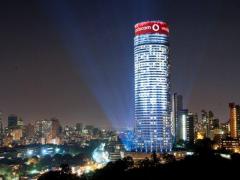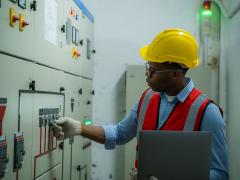Chris Yelland, Managing Director at EE Business Intelligence, writes about the symbiotic relationship between industrialisation and clean energy.

A landmark study by the Development Bank of Southern Africa (DBSA), Presidential Climate Commission (PCC), National Planning Commission (NPC) and National Treasury’s SA-TIED programme, stands as a counterpoint to the Ministry of Energy & Electricity’s recently gazetted Integrated Resource Plan for electricity, IRP 2025.
Published on 5 November 2025, the study represents the most comprehensive assessment yet of South Africa’s transition to a low-carbon power system, and combines advanced technical modelling with market analysis, policy review and financial diagnostics.
The study’s overriding purpose is to identify how South Africa can achieve energy security at the lowest cost while meeting net-zero commitments by 2050. It develops three scenarios – Green Industrialisation (Scenario A), Market Forces (Scenario B), and Business-As-Usual (Scenario C) – each reflecting different combinations of domestic policy ambition and global climate alignment.
Across all scenarios, the conclusion is striking: the pathway most closely aligned with the Paris Agreement, Scenario A, also delivers the lowest overall system cost, revealing that economic efficiency and climate ambition are not in conflict but mutually reinforcing.
The context: From load-shedding to long-term security
After more than a decade of debilitating load-shedding, South Africa’s energy landscape stands at a crossroads. The study situates this recovery within a global transformation towards electrification and decarbonisation.
National imperatives – including the Nationally Determined Contributions (NDCs), National Development Plan 2030, and Sustainable Development Goal 7 – are supported by new strategic instruments such as the Just Energy Transition Investment Plan, Transmission Development Plan 2024, and the Electricity Regulation Amendment Act (2024).
Electricity access currently reaches around 86% of households, yet generation, transmission and distribution reliability remains constrained, with the energy-availability factor averaging 59.8% in 2024. Renewable energy provides less than 10% of total electrical energy supply.
Meeting the NDC target band of 350 – 420 Mt CO₂-equivalent by 2030, while achieving universal access, will therefore require the largest expansion of new generation and grid capacity in the country’s history.
Methodology: A “beyond-the-gap” framework
The analysis adapts the World Bank’s “Beyond the Gap” methodology, combining infrastructure modelling with financial-market diagnostics and policy evaluation. It first defines measurable objectives – energy access, affordability, emissions reduction and system reliability – and then quantifies the investment needed to achieve them under different external conditions.
Six core metrics guide the evaluation: electricity access, renewable-energy share, energy efficiency, energy-availability factor, affordability (annualised Capex + Opex), and CO₂ emissions.
To these are added external factors such as global fuel prices, technology learning rates, cost of capital, and the degree of international policy coordination.
Complementary socio-economic modelling under the SA-TIED programme assesses the employment and GDP effects of each pathway, ensuring that energy security and a just transition are analysed in tandem.
Three pathways modelled
The study defines three intersecting pathways, as follows:
- Scenario A (Green Industrialisation): assumes both global 1.5 °C alignment and strong domestic policy coherence, with a strict carbon budget of 2 gigatonnes for the electricity sector by 2050, early air-quality compliance by 2030, and preferential financing for renewable technologies for rapid decarbonisation.
- Scenario B (Market Forces): reflects moderate ambition where carbon budgets are looser, compliance dates slip to 2035, and technology learning rates are more conservative.
- Scenario C (Business-As-Usual): assumes weak climate cooperation and prioritises short-term least-cost fossil generation with minimal regulation.
- Crucially, all three scenarios demonstrate that South Africa can meet future electricity demand without building new coal or nuclear capacity, provided renewables, storage and flexible gas are deployed at scale and on time.
System outcomes: generation mix; missions; grid expansion
By 2050, renewable sources dominate the generation mix in all but the business-as-usual case.
Under Scenario A, installed solar PV capacity reaches 99 GW and wind 48 GW, supported by 53 GW of battery-energy storage and 23 GW of flexible gas turbines. The coal fleet declines from 37 GW in 2025 to 10 GW – all retrofitted with carbon-capture systems by mid-century. These generation shifts translate directly into the emissions trajectory.
Starting from roughly 436 Mt CO₂-eq in 2022, Scenario A achieves 123 Mt by 2030 and 8 Mt by 2050, well within South Africa’s NDC range and consistent with net-zero goals. Scenario B peaks at the upper edge of the NDC band in 2030 and falls to 51 Mt by 2050, while Scenario C remains heavily carbon-intensive at 129 Mt in 2050.
Power-flow modelling identifies new 765 kV transmission corridors as essential backbones for transporting renewable electricity from high-resource zones to demand centres.
The scale of grid expansion is immense: collector networks to integrate distributed solar and battery systems account for nearly half of total grid-investment costs, highlighting the need for coordinated planning between Eskom, the emerging NTCSA, the private sector and municipalities.
Investment requirements and cost dynamics
Over the 25-year horizon from 2025 to 2050, total system investment ranges between R3.6 trillion and R4.2 trillion (discounted 8% to 2024 real terms). Despite requiring the largest upfront capital deployment, Green Industrialisation (Scenario A) ultimately proves to be the most affordable overall. Its early build-out of renewables and storage drives steep cost declines through technology learning and reduced fuel dependence.
By contrast, the Business-As-Usual case (Scenario C), while deferring investment initially, accumulates the highest lifetime cost because of ongoing fossil-fuel expenditure and slower innovation uptake. Generation accounts for roughly 90% of total system costs, but grid infrastructure rises in importance, comprising between 6 and 11% depending on the scenario.
Scenario A allocates R383 Billion to transmission and distribution expansion, reflecting the larger spatial footprint of renewable energy generation. On average, the country must mobilise around R140 Billion per year in new energy-sector investment through the 2030s – a scale that cannot be achieved through public finance alone.
Funding gap and market-sounding insights
The study leader’s market-sounding among banks, pension funds, DFIs and independent power producers reveals a nuanced picture: liquidity exists in the short term, but regulatory uncertainty and project-pipeline weakness threaten future flows.
Investors expressed confidence in renewable-generation finance but also some concern about the absence of clear frameworks for transmission investment, grid access and tariff setting. Financiers pointed to inconsistent procurement cycles, Eskom’s backlog in BQ (budget quote) applications, and delays in IRP (Integrated Resource Plan for electricity) updates as barriers to bankability.
Competitive bidding has compressed margins to levels that deter new entrants, while uncertainty around carbon-tax policy and gas-to-power regulation adds perceived risk. While most participants believe current funding is sufficient to meet near-term renewable targets, they anticipate a significant capital shortfall beyond 2030 as project volumes rise.
Under conservative assumptions, the study estimates a Capex gap of 0.6 – 0.8% of GDP per year between 2028 and 2030 for Scenario A. When Opex is included, total financing requirements could reach between 1.5 and 2.4% of GDP annually through 2050.
The study finds that the gap is not purely financial but institutional: South Africa lacks the coordinated regulatory architecture to channel capital efficiently into grid and storage assets.
Policy and regulatory reform
The policy review paints a sobering picture of a fragmented and sometimes contradictory regulatory environment. While the Constitution implicitly guarantees access to electricity as part of socio-economic rights, there is no explicit legislative framework enshrining renewable energy as a national priority.
Foundational policies such as the 1998 White Paper on Energy Policy and the draft South African Renewable Energy Masterplan (SAREM 2022) outline strategic intent but remain weak on implementation. Regulation 28 of the Pension Funds Act now allows retirement funds to allocate up to 45% of assets to infrastructure and 15% to private equity, potentially unlocking billions in domestic capital.
Yet, without a unified infrastructure-investment statute and consistent tariff-setting methodology, investor confidence will remain fragile. The report draws lessons from international best practice, noting that countries like Chile and India have legislated integrated planning and independent regulatory oversight – reforms South Africa must emulate to accelerate energy investment.
Comparative Scenario Economics
Scenario A emerges as both the most climate-aligned and least-cost option, achieving deep decarbonisation while limiting total system expenditure. Scenario B offers transitional flexibility but higher operating costs; Scenario C sacrifices long-term efficiency for short-term savings.
| Indicator (2025 – 2050, discounted 8%) | Scenario A | Scenario B | Scenario C |
| Generation Capex (R bn) | 1651 | 1229 | 1446 |
| O&M + fuel (R bn) | 1552 | 2166 | 2490 |
| Grid Capex (R bn) | 383 | 262 | 231 |
| Total system cost (R bn) | 3586 | 3657 | 4166 |
| 2050 CO₂ emissions (Mt/a) | 8 | 51 | 129 |
Institutional challenges and strategic implications
Implementing the green industrialisation pathway will test South Africa’s technical and institutional capacity. Achieving an average of 7 GW per year of new renewable build between 2025 and 2030 demands streamlined permitting, rapid grid-connection approvals, and professional project management.
The transition will also require targeted social-protection measures in coal-dependent provinces such as Mpumalanga, ensuring the shift is genuinely “just.” For policymakers, the evidence is unambiguous: treating electricity infrastructure as strategic national investment – on par with water or transport networks – is essential.
A predictable revenue framework, coherent planning between the Department of Energy & Electricity, NTCSA and the private sector, and accelerated market liberalisation through the forthcoming South African Wholesale Electricity Market (SAWEM) are critical enablers.
Conclusion: Implementation now, not later
The NPC/DBSA/PCC/SA-TIED study delivers a clear message: delaying the transition will cost more – economically, socially and environmentally – than acting decisively today.
The green industrialisation scenario demonstrates that a clean-energy future is not only attainable but financially prudent. The task ahead is one of execution, not further debate.
If implemented with urgency, South Africa could achieve near-universal access, end load-shedding, meet its NDC targets, and position itself as a regional powerhouse in renewable-energy and associated green industrialisation exports.
© Copyright 2025 – EE Business Intelligence (Pty) Ltd. All rights reserved. This article may not be published without the written permission of EE Business Intelligence.














